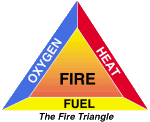History
Since the early 1800's, chemists have constantly exposed many elements and minerals to fire to determine their effect in an attempt to change the composition of the elements and as a result have stumbled upon new discoveries that interrupted the fire triangle. Scientists have determined that fire requires 4 elements to progress. 1) Oxygen, 2) Fuel, 3) Heat, and 4) The process of combustion (chain reaction); thus the fire triangle was born.
By eliminating just one of these elements can stop a fire from progressing. Flame-Stoptm Fire Retardants were developed so that when applied to the fuel ( lumbar, plywood, timbers or any combustible substance), a "charring" effect would occur when exposed to heat from a fire. This "charring" effect is created when the heat from a fire initiates a chemical reaction of the fire retardant. Tiny fire resistant bubbles develop and swell to from an insulating barrier between the fire and the fuel. Inert gases are also released which reduce amount of oxygen available for combustion.
Fire retardants are defined as "an approved chemical, chemical compound or mixture which, when applied in an approved manner to any fabric or other material, will render such fabric or material incapable of supporting combustion".* Fire retardants are tested based on "flame spread" standards as established by building and organizations such as the "National Fire Protection Association (NFPA), Uniform Fire Code (UFC), and American Society for Testing and Materials (ASTM)". Many local governmental organizations are adopting these building codes as their local standard guidelines.
About Fire Retardants*
If you are a Property Owner, Architect, Builder, Or Contractor…..it is up to you to require and demand these safety features and applications. Fire Retardants save valuable property, family heirlooms and precious lives at a small cost.
Four components are necessary for fire: 1) fuel, 2) oxygen, 3) a source of ignition (heat) and 4) a chemical, exothermic reaction. Although only one component need be eliminated to extinguish a fire, Flame-Stop™ Protectant chemicals produce outstanding fire inhibiting results by eliminating two of these components. The purpose of these chemicals and products are to render materials virtually nonflammable. One of the keys is to make a chemical change in the material. When this change occurs, it renders the material non-combustible.
Flame-Stop™ fire retardants have been in use for over 30 years. When it comes to saving property and lives you need the very best protection you can buy. Flame-Stop™ chemistry was designed to interfere with the fire and ignition process to prevent the massive fire burn-outs you see today. The Flame-Stop™ compounds when applied to lumber, plywood, timbers will automatically react in the presence of heat or flame. The chemistry converts combustible gases and tars to a non-combustible carbon char, nitrogen and carbon dioxide. The increase in carbon char helps to keep the flame or fire from regenerating. The nitrogen produced as a by-product displaces oxygen and smothers the flame. Flame-Stop™ chemical reaction separates the fuel component from the source of ignition.
When wood surfaces are treated with Flame-Stop™ products, the chemicals will penetrate the wood. The chemical balance is then changed inside and the surface will react to heat and flame. The change that occurs is permanently in place when not exposed to weather or will last 5 years when exposed to weather without paint or other type of covering. Paper products can also be protected as well as fabrics, foams, veneers, latex-based paints, live cut Christmas trees, and much more. Another important factor is the wood or other materials treated at this point will not ignite or contribute to the fire process. This is known as "retarding the propagation of the fire", which are rated and are given a "flame spread number" by accredited testing agencies. The other outstanding factor is the significant reduction in smoke. These chemicals have been known to cut smoke from 40% - 80%. Smoke inhalation causes more deaths than fire and becomes an important factor.
